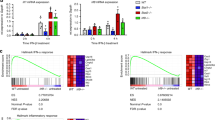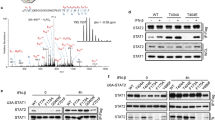Abstract
Interferon regulatory factors (IRFs) regulate transcription of interferon genes through DNA sequence-specific binding to these targets. Using a differential display method for examining gene expression in p53-defective cells infected with adenovirus containing wild-type p53, we found that expression of interferon regulatory factor 5 (IRF-5) mRNA was increased in the presence of exogenous p53. An electrophoretic mobility-shift assay showed that a potential p53 binding site (p53BS) detected in exon 2 of the IRF-5 gene could in fact bind to p53 protein. Moreover, a heterologous reporter assay revealed that the p53BS possessed p53-dependent transcriptional activity. Expression of IRF-5 was induced in p53+/+ cells (MCF7 and NHDF), but not inp53−/− cells (H1299) when DNA was damaged by γ-irradiation, UV-radiation, or adriamycin treatment in a wild-type p53-dependent manner. These results suggest that IRF-5 is a novel p53-target, and that it might mediate the p53-dependent immune response.
This is a preview of subscription content, access via your institution
Access options
Subscribe to this journal
Receive 50 print issues and online access
$259.00 per year
only $5.18 per issue
Buy this article
- Purchase on Springer Link
- Instant access to full article PDF
Prices may be subject to local taxes which are calculated during checkout





Similar content being viewed by others
References
Driggers PH, Ennist DL, Gleason SL, Mak WH, Marks MS, Levi BZ, Flanagan JR, Appella E, Ozato K . 1990 Proc. Natl. Acad. Sci. USA 87: 3743–3747
el-Deiry WS, Kern SE, Pietenpol JA, Kinzler KW, Vogelstein B . 1992 Nat. Genet. 1: 45–49
el-Deiry WS, Tokino T, Velculescu VE, Levy DB, Parsons R, Trent JM, Lin D, Mercer WE, Kinzler WE, Vogelstein B . 1993 Cell 75: 817–825
Furuhata T, Tokino T, Urano T, Nakamura Y . 1996 Oncogene 13: 1965–1970
Greenblatt MS, Bennett WP, Hollstein M, Harris CC . 1994 Cancer Res. 54: 4855–4878
Han HJ, Tokino T, Nakamura Y . 1998 Hum. Mol. Genet. 7: 1039–1046
Harada H, Taniguchi T, Tanaka N . 1998 Biochimie 80: 641–650
Harper JW, Adami GR, Wei N, Keyomarsi K, Elledge SJ . 1993 Cell 75: 805–816
Kim T, Kim TY, Song YH, Min IM, Yim J, Kim TK . 1999 J. Biol. Chem. 274: 30686–30689
Levine AJ . 1997 Cell 88: 323–331
Matsuyama T, Grossman A, Mittrucker HW, Siderovski DP, Kiefer F, Kawakami T, Richardson CD, Taniguchi T, Yoshinaga SK, Mak TW . 1995 Nucl. Acids Res. 23: 2127–2136
Miyashita T, Reed JC . 1995 Cell 80: 293–299
Ng CC, Koyama K, Okamura S, Kondoh H, Takei Y, Nakamura Y . 1999 Genes Chrom. Cancer 26: 329–335
Nishimori H, Shiratsuchi T, Urano T, Kimura Y, Kiyono K, Tatsumi K, Yoshida S, Ono M, Kuwano M, Nakamura Y, Tokino T . 1997 Oncogene 15: 2145–2150
Oda K, Arakawa H, Tanaka T, Matsuda K, Tanikawa C, Mori T, Nishimori H, Tamai K, Tokino T, Nakamura Y, Taya Y . 2000 Cell 102: 849–862
Okamura S, Arakawa H, Tanaka T, Nakanishi H, Ng CC, Taya Y, Monden M, Nakamura Y . 2001 Mol. Cell 8: 85–94
Pitha PM, Au WC, Lowther W, Juang YT, Schafer SL, Burysek L, Hiscott J, Moore PA . 1998 Biochimie 80: 651–658
Shiraishi K, Fukuda S, Mori T, Matsuda K, Yamaguchi T, Tanikawa C, Ogawa M, Nakamura Y, Arakawa H . 2000 Cancer Res. 60: 3722–3726
Takei Y, Ishikawa S, Tokino T, Muto T, Nakamura Y . 1998 Genes Chrom. Cancer 23: 1–9
Tamura T, Ishihara M, Lamphier MS, Tanaka N, Oishi I, Aizawa S, Matsuyama T, Mak TW, Taki S, Taniguchi T . 1995 Nature 376: 596–599
Tanaka H, Arakawa H, Yamaguchi T, Shiraishi K, Fukuda S, Matsui K, Takei Y, Nakamura Y . 2000 Nature 404: 42–49
Tanaka N, Ishihara M, Kitagawa M, Harada H, Kimura T, Matsuyama T, Lamphier MS, Aizawa S, Mak TW, Taniguchi T . 1994 Cell 77: 829–839
Tanaka N, Ishihara M, Lamphier MS, Nozawa H, Matsuyama T, Mak TW, Aizawa S, Tokino T, Oren M, Taniguchi T . 1996 Nature 382: 816–818
Tokino T, Thiagalingam S, el-Deiry WS, Waldman T, Kinzler KW, Vogelstein B . 1994 Hum. Mol. Genet. 3: 1537–1542
Urano T, Nishimori H, Han H, Furuhata T, Kimura Y, Nakamura Y, Tokino T . 1997 Cancer Res. 57: 3281–3287
Acknowledgements
We thank K Matsui for her excellent technical assistance. This work was supported in part by Grant #13216031 from the Ministry of Education, Culture, Sports, Science and Technology (to H Arakawa) and in part by ‘Research for the Future’ Program Grant #00L01402 from The Japan Society for the Promotion of Science (to Y Nakamura).
Author information
Authors and Affiliations
Corresponding author
Rights and permissions
About this article
Cite this article
Mori, T., Anazawa, Y., Iiizumi, M. et al. Identification of the interferon regulatory factor 5 gene (IRF-5) as a direct target for p53. Oncogene 21, 2914–2918 (2002). https://doi.org/10.1038/sj.onc.1205459
Received:
Revised:
Accepted:
Published:
Issue Date:
DOI: https://doi.org/10.1038/sj.onc.1205459
Keywords
This article is cited by
-
Translating p53-based therapies for cancer into the clinic
Nature Reviews Cancer (2024)
-
Regulation of immunological tolerance by the p53-inhibitor iASPP
Cell Death & Disease (2023)
-
Crosstalk between microglia and patient-derived glioblastoma cells inhibit invasion in a three-dimensional gelatin hydrogel model
Journal of Neuroinflammation (2020)
-
Immunological impact of cell death signaling driven by radiation on the tumor microenvironment
Nature Immunology (2020)
-
The Role of Interferon Regulatory Factor 5 in Macrophage Inflammation During Osteoarthritis
Inflammation (2019)



